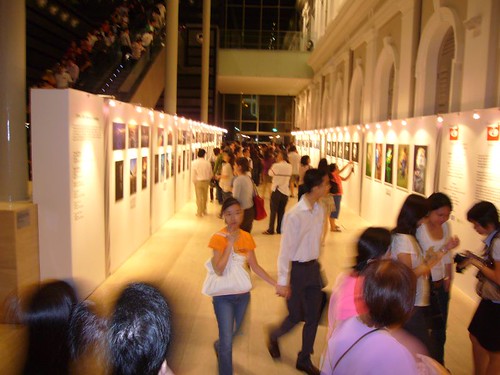
NHB’s Night Festival 2008
I love reading Nina Simon’s Museum 2.0 blog for her cutting insights on stuff happening in my neck of the woods. One of the issues that she recently wrote about – audience development – is something that museums and art galleries in Singapore are also grappling with.
In her post, Nina questioned the need for museums to organise “hip” events to attract younger audiences at the expense of alienating a broader more diverse crowd. While many museums have shifted from being a “cabinet of curiosities” for an elite few to “community destinations”, the question now arises whether their activities should be narrowly focused on distinct segments or appeal more broadly across visitor groups.
I believe that we can achieve both if we play our cards right. Like libraries and parks, museums serve diverse communities hailing from different age groups, interests, behaviours and backgrounds.
By offering a plethora of experiences – thematic exhibitions, focused events, varied dining options for instance – museums can attract a wider proportion of the community. These can perhaps be considered across different spaces and timings, and with different marketing channels to reach the targeted groups.
For instance, a Friday night “chill out with culture” session can perhaps reach out to the youths and young adults, while a Sunday “Family Fun” event can be targeted at families with kids.
To address the issue of possibly alienating one group from another, more general activities could also be organised. Examples in Singapore include the popular Singapore HeritageFest, Night Festival and International Museum Day events. These broader appeal events would reach wider demographic and psychographic segments.
Beyond short-term events and festivals, the more important audience development question is one of engendering ownership and triggering grassroots advocacy amongst different groups. Other than our dear volunteers who also work as docents, can the museums reach out to a wider spectrum of society and get them to “own” parts of the experience?
As public institutions, museums really belong to the people (cliched though that may sometimes sound), and it is important for the public – regardless of their stations in life – to feel that it is a part of their lives. However, there is also a need to ensure some degree of academic rigour and scholastic discipline is maintained.
Can museums relinquish some control over to their audiences (perhaps a better term in future would be associates or public stakeholders) such that they have a greater role in adding to its cultural narrative? How can these be done in a manner that respects curatorial authority and integrity while embracing participation such that they can be an integral part of communities around the world?

My short answer: Masses of Niche Audiences.
Technology allows us to create multiple unique experiences in the same physical environment. (Think Augmented Reality, Mobile Apps, Indoor Positioning).
You can create augmented experiences that’s relevant to multiple people of different backgrounds. For instance, you and I can be standing in front of the same exhibit, but could be getting different forms of content on different platforms in different styles of expression.
That way, when I visit a museum alone, I receive info that “just right for me”; and when I visit with friends, we all get the tools to share our multiple perspectives – making the experience not just about the museum, but of the people and the relationships they share.
With large museums, I suppose it’d be helpful to be able to employ a diversity of outreach staff who are good with different audiences.
E.g. some are better at tailoring needs for a younger set or kids or an older group. And outlook is another parameter, beyond age. An innate understanding of specific interest will express itself effectively with these groups.
Well, have fun with this! So much to do!